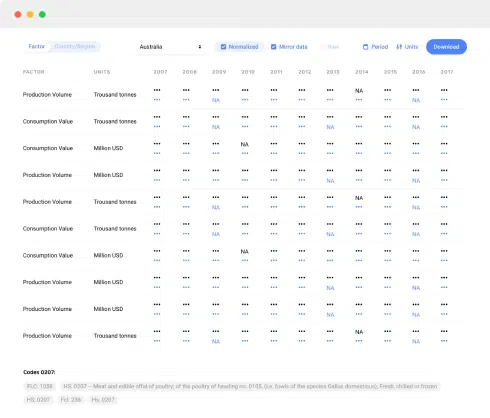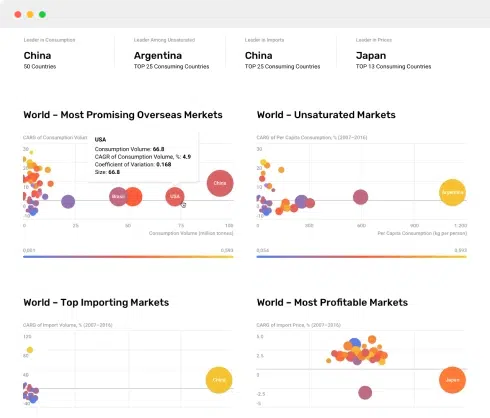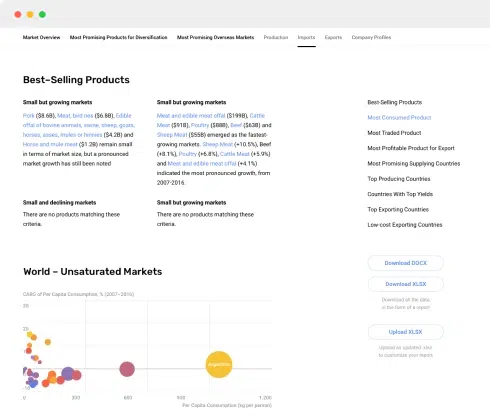
Africa - Prepared Additives for Cements, Mortars or Concretes - Market Analysis, Forecast, Size, Trends and Insights
Get instant access to more than 2 million reports, dashboards, and datasets on the IndexBox Platform.
View PricingAfrica: Market for Prepared Additives For Cements, Mortars Or Concretes 2025
Market Size for Prepared Additives For Cements, Mortars Or Concretes in Africa
After two years of growth, the African prepared additives for cements market decreased by -1.5% to $X in 2022. Over the period under review, consumption saw strong growth. As a result, consumption reached the peak level of $X. From 2017 to 2022, the growth of the market failed to regain momentum.
Production of Prepared Additives For Cements, Mortars Or Concretes in Africa
In value terms, prepared additives for cements production expanded markedly to $X in 2022 estimated in export price. In general, production, however, posted a perceptible expansion. The growth pace was the most rapid in 2018 with an increase of 58%. Over the period under review, production hit record highs at $X in 2020; however, from 2021 to 2022, production stood at a somewhat lower figure.
Exports of Prepared Additives For Cements, Mortars Or Concretes
Exports in Africa
In 2022, approx. X tons of prepared additives for cements, mortars or concretes were exported in Africa; increasing by 12% against the previous year's figure. In general, exports, however, recorded a abrupt setback. The most prominent rate of growth was recorded in 2019 when exports increased by 26%. The volume of export peaked at X tons in 2012; however, from 2013 to 2022, the exports failed to regain momentum.
In value terms, prepared additives for cements exports expanded to $X in 2022. Total exports indicated a tangible increase from 2012 to 2022: its value increased at an average annual rate of +3.2% over the last decade. The trend pattern, however, indicated some noticeable fluctuations being recorded throughout the analyzed period. Based on 2022 figures, exports increased by +43.8% against 2020 indices. The most prominent rate of growth was recorded in 2021 when exports increased by 38% against the previous year. The level of export peaked in 2022 and is expected to retain growth in the immediate term.
Exports by Country
South Africa represented the main exporting country with an export of around X tons, which resulted at 63% of total exports. Kenya (X tons) took a 14% share (based on physical terms) of total exports, which put it in second place, followed by Egypt (8.6%). Cote d'Ivoire (X tons), Morocco (X tons) and Seychelles (X tons) followed a long way behind the leaders.
From 2012 to 2022, average annual rates of growth with regard to prepared additives for cements exports from South Africa stood at -6.6%. At the same time, Kenya (+25.5%), Cote d'Ivoire (+15.1%), Seychelles (+12.8%) and Morocco (+2.8%) displayed positive paces of growth. Moreover, Kenya emerged as the fastest-growing exporter exported in Africa, with a CAGR of +25.5% from 2012-2022. By contrast, Egypt (-13.2%) illustrated a downward trend over the same period. Kenya (+13 p.p.) and Cote d'Ivoire (+2.8 p.p.) significantly strengthened its position in terms of the total exports, while South Africa and Egypt saw its share reduced by -10.6% and -12.5% from 2012 to 2022, respectively. The shares of the other countries remained relatively stable throughout the analyzed period.
In value terms, South Africa ($X) remains the largest prepared additives for cements supplier in Africa, comprising 63% of total exports. The second position in the ranking was taken by Egypt ($X), with a 12% share of total exports. It was followed by Kenya, with a 9.3% share.
In South Africa, prepared additives for cements exports increased at an average annual rate of +2.6% over the period from 2012-2022. In the other countries, the average annual rates were as follows: Egypt (+0.4% per year) and Kenya (+27.4% per year).
Export Prices by Country
The export price in Africa stood at $X per ton in 2022, with a decrease of -6.6% against the previous year. In general, the export price, however, enjoyed a resilient expansion. The most prominent rate of growth was recorded in 2016 an increase of 43%. The level of export peaked at $X per ton in 2021, and then dropped in the following year.
Prices varied noticeably by country of origin: amid the top suppliers, the country with the highest price was Egypt ($X per ton), while Kenya ($X per ton) was amongst the lowest.
From 2012 to 2022, the most notable rate of growth in terms of prices was attained by Egypt (+15.7%), while the other leaders experienced more modest paces of growth.
Imports of Prepared Additives For Cements, Mortars Or Concretes
Imports in Africa
In 2022, approx. X tons of prepared additives for cements, mortars or concretes were imported in Africa; with an increase of 9.5% against 2021. In general, imports continue to indicate buoyant growth. The most prominent rate of growth was recorded in 2016 with an increase of 1,708%. As a result, imports attained the peak of X tons. From 2017 to 2022, the growth of imports remained at a somewhat lower figure.
In value terms, prepared additives for cements imports expanded rapidly to $X in 2022. The total import value increased at an average annual rate of +4.4% from 2012 to 2022; however, the trend pattern indicated some noticeable fluctuations being recorded throughout the analyzed period. The pace of growth was the most pronounced in 2013 with an increase of 29%. Over the period under review, imports hit record highs in 2022 and are expected to retain growth in years to come.
Imports by Country
Egypt (X tons), Morocco (X tons) and Algeria (X tons) represented roughly 34% of total imports in 2022. It was distantly followed by Nigeria (X tons), achieving a 5.1% share of total imports. The following importers - Tanzania (X tons), South Africa (X tons), Ghana (X tons), Kenya (X tons), Libya (X tons), Angola (X tons), Senegal (X tons), Djibouti (X tons) and Niger (X tons) - together made up 31% of total imports.
From 2012 to 2022, the most notable rate of growth in terms of purchases, amongst the main importing countries, was attained by Niger (with a CAGR of +50.4%), while imports for the other leaders experienced more modest paces of growth.
In value terms, the largest prepared additives for cements importing markets in Africa were Egypt ($X), Morocco ($X) and Algeria ($X), with a combined 38% share of total imports. Nigeria, Tanzania, Niger, South Africa, Kenya, Ghana, Angola, Senegal, Libya and Djibouti lagged somewhat behind, together accounting for a further 33%.
Niger, with a CAGR of +49.0%, saw the highest growth rate of the value of imports, among the main importing countries over the period under review, while purchases for the other leaders experienced more modest paces of growth.
Import Prices by Country
In 2022, the import price in Africa amounted to $X per ton, increasing by 4.9% against the previous year. Over the period under review, the import price, however, recorded a mild decline. The growth pace was the most rapid in 2017 when the import price increased by 1,735%. The level of import peaked at $X per ton in 2013; however, from 2014 to 2022, import prices remained at a lower figure.
Prices varied noticeably by country of destination: amid the top importers, the country with the highest price was Niger ($X per ton), while Djibouti ($X per ton) was amongst the lowest.
From 2012 to 2022, the most notable rate of growth in terms of prices was attained by Morocco (+1.3%), while the other leaders experienced a decline in the import price figures.
Source: IndexBox Platform
Frequently Asked Questions (FAQ) :
This report provides an in-depth analysis of the market for prepared additives for cements in Africa. Within it, you will discover the latest data on market trends and opportunities by country, consumption, production and price developments, as well as the global trade (imports and exports). The forecast exhibits the market prospects through 2030.
Product coverage:
- Prodcom 20595750 - Prepared additives for cements, mortars or concretes
Country coverage:
- Algeria
- Angola
- Benin
- Botswana
- Burkina Faso
- Burundi
- Cabo Verde
- Cameroon
- Central African Republic
- Chad
- Comoros
- Congo
- Democratic Republic of the Congo
- Djibouti
- Egypt
- Equatorial Guinea
- Eritrea
- Ethiopia
- Gabon
- Gambia
- Ghana
- Guinea
- Guinea-Bissau
- Kenya
- Lesotho
- Liberia
- Libya
- Madagascar
- Malawi
- Mali
- Mauritania
- Mauritius
- Mayotte
- Morocco
- Mozambique
- Namibia
- Niger
- Nigeria
- Reunion
- Rwanda
- Saint Helena, Ascension and Tristan da Cunha
- Sao Tome and Principe
- Senegal
- Seychelles
- Sierra Leone
- Somalia
- South Africa
- Sudan
- Swaziland
- Tanzania
- Togo
- Tunisia
- Uganda
- Zambia
- Zimbabwe
- Cote d'Ivoire
- Western Sahara
- South Sudan
Data coverage:
- Market volume and value
- Per Capita consumption
- Forecast of the market dynamics in the medium term
- Production in Africa, split by region and country
- Trade (exports and imports) in Africa
- Export and import prices
- Market trends, drivers and restraints
- Key market players and their profiles
Reasons to buy this report:
- Take advantage of the latest data
- Find deeper insights into current market developments
- Discover vital success factors affecting the market
This report is designed for manufacturers, distributors, importers, and wholesalers, as well as for investors, consultants and advisors.
In this report, you can find information that helps you to make informed decisions on the following issues:
- How to diversify your business and benefit from new market opportunities
- How to load your idle production capacity
- How to boost your sales on overseas markets
- How to increase your profit margins
- How to make your supply chain more sustainable
- How to reduce your production and supply chain costs
- How to outsource production to other countries
- How to prepare your business for global expansion
While doing this research, we combine the accumulated expertise of our analysts and the capabilities of artificial intelligence. The AI-based platform, developed by our data scientists, constitutes the key working tool for business analysts, empowering them to discover deep insights and ideas from the marketing data.
1. INTRODUCTION
Making Data-Driven Decisions to Grow Your Business
- REPORT DESCRIPTION
- RESEARCH METHODOLOGY AND THE AI PLATFORM
- DATA-DRIVEN DECISIONS FOR YOUR BUSINESS
- GLOSSARY AND SPECIFIC TERMS
2. EXECUTIVE SUMMARY
A Quick Overview of Market Performance
- KEY FINDINGS
- MARKET TRENDS This Chapter is Available Only for the Professional EditionPRO
3. MARKET OVERVIEW
Understanding the Current State of The Market and its Prospects
- MARKET SIZE: HISTORICAL DATA (2012–2024) AND FORECAST (2025–2035)
- CONSUMPTION BY COUNTRY: HISTORICAL DATA (2012–2024) AND FORECAST (2025–2035)
- MARKET FORECAST TO 2035
4. MOST PROMISING PRODUCTS FOR DIVERSIFICATION
Finding New Products to Diversify Your Business
- TOP PRODUCTS TO DIVERSIFY YOUR BUSINESS
- BEST-SELLING PRODUCTS
- MOST CONSUMED PRODUCTS
- MOST TRADED PRODUCTS
- MOST PROFITABLE PRODUCTS FOR EXPORT
5. MOST PROMISING SUPPLYING COUNTRIES
Choosing the Best Countries to Establish Your Sustainable Supply Chain
- TOP COUNTRIES TO SOURCE YOUR PRODUCT
- TOP PRODUCING COUNTRIES
- TOP EXPORTING COUNTRIES
- LOW-COST EXPORTING COUNTRIES
6. MOST PROMISING OVERSEAS MARKETS
Choosing the Best Countries to Boost Your Export
- TOP OVERSEAS MARKETS FOR EXPORTING YOUR PRODUCT
- TOP CONSUMING MARKETS
- UNSATURATED MARKETS
- TOP IMPORTING MARKETS
- MOST PROFITABLE MARKETS
7. PRODUCTION
The Latest Trends and Insights into The Industry
- PRODUCTION VOLUME AND VALUE: HISTORICAL DATA (2012–2024) AND FORECAST (2025–2035)
- PRODUCTION BY COUNTRY: HISTORICAL DATA (2012–2024) AND FORECAST (2025–2035)
8. IMPORTS
The Largest Import Supplying Countries
- IMPORTS: HISTORICAL DATA (2012–2024) AND FORECAST (2025–2035)
- IMPORTS BY COUNTRY: HISTORICAL DATA (2012–2024) AND FORECAST (2025–2035)
- IMPORT PRICES BY COUNTRY: HISTORICAL DATA (2012–2024) AND FORECAST (2025–2035)
9. EXPORTS
The Largest Destinations for Exports
- EXPORTS: HISTORICAL DATA (2012–2024) AND FORECAST (2025–2035)
- EXPORTS BY COUNTRY: HISTORICAL DATA (2012–2024) AND FORECAST (2025–2035)
- EXPORT PRICES BY COUNTRY: HISTORICAL DATA (2012–2024) AND FORECAST (2025–2035)
10. PROFILES OF MAJOR PRODUCERS
The Largest Producers on The Market and Their Profiles
-
11. COUNTRY PROFILES
The Largest Markets And Their Profiles
This Chapter is Available Only for the Professional Edition PRO- Algeria
- Angola
- Benin
- Botswana
- Burkina Faso
- Burundi
- Cabo Verde
- Cameroon
- Central African Republic
- Chad
- Comoros
- Congo
- Democratic Republic of the Congo
- Djibouti
- Egypt
- Equatorial Guinea
- Eritrea
- Ethiopia
- Gabon
- Gambia
- Ghana
- Guinea
- Guinea-Bissau
- Kenya
- Lesotho
- Liberia
- Libya
- Madagascar
- Malawi
- Mali
- Mauritania
- Mauritius
- Mayotte
- Morocco
- Mozambique
- Namibia
- Niger
- Nigeria
- Reunion
- Rwanda
- Saint Helena, Ascension and Tristan da Cunha
- Sao Tome and Principe
- Senegal
- Seychelles
- Sierra Leone
- Somalia
- South Africa
- Sudan
- Swaziland
- Tanzania
- Togo
- Tunisia
- Uganda
- Zambia
- Zimbabwe
- Cote d'Ivoire
- Western Sahara
- South Sudan
LIST OF TABLES
- Key Findings In 2024
- Market Volume, In Physical Terms: Historical Data (2012–2024) and Forecast (2025–2035)
- Market Value: Historical Data (2012–2024) and Forecast (2025–2035)
- Per Capita Consumption, by Country, 2022–2024
- Production, In Physical Terms, By Country: Historical Data (2012–2024) and Forecast (2025–2035)
- Imports, In Physical Terms, By Country: Historical Data (2012–2024) and Forecast (2025–2035)
- Imports, In Value Terms, By Country: Historical Data (2012–2024) and Forecast (2025–2035)
- Import Prices, By Country: Historical Data (2012–2024) and Forecast (2025–2035)
- Exports, In Physical Terms, By Country: Historical Data (2012–2024) and Forecast (2025–2035)
- Exports, In Value Terms, By Country: Historical Data (2012–2024) and Forecast (2025–2035)
- Export Prices, By Country: Historical Data (2012–2024) and Forecast (2025–2035)
LIST OF FIGURES
- Market Volume, In Physical Terms: Historical Data (2012–2024) and Forecast (2025–2035)
- Market Value: Historical Data (2012–2024) and Forecast (2025–2035)
- Consumption, by Country, 2024
- Market Volume Forecast to 2035
- Market Value Forecast to 2035
- Market Size and Growth, By Product
- Average Per Capita Consumption, By Product
- Exports and Growth, By Product
- Export Prices and Growth, By Product
- Production Volume and Growth
- Exports and Growth
- Export Prices and Growth
- Market Size and Growth
- Per Capita Consumption
- Imports and Growth
- Import Prices
- Production, In Physical Terms: Historical Data (2012–2024) and Forecast (2025–2035)
- Production, In Value Terms: Historical Data (2012–2024) and Forecast (2025–2035)
- Production, by Country, 2024
- Production, In Physical Terms, by Country: Historical Data (2012–2024) and Forecast (2025–2035)
- Imports, In Physical Terms: Historical Data (2012–2024) and Forecast (2025–2035)
- Imports, In Value Terms: Historical Data (2012–2024) and Forecast (2025–2035)
- Imports, In Physical Terms, By Country, 2024
- Imports, In Physical Terms, By Country: Historical Data (2012–2024) and Forecast (2025–2035)
- Imports, In Value Terms, By Country: Historical Data (2012–2024) and Forecast (2025–2035)
- Import Prices, By Country: Historical Data (2012–2024) and Forecast (2025–2035)
- Exports, In Physical Terms: Historical Data (2012–2024) and Forecast (2025–2035)
- Exports, In Value Terms: Historical Data (2012–2024) and Forecast (2025–2035)
- Exports, In Physical Terms, By Country, 2024
- Exports, In Physical Terms, By Country: Historical Data (2012–2024) and Forecast (2025–2035)
- Exports, In Value Terms, By Country: Historical Data (2012–2024) and Forecast (2025–2035)
- Export Prices, By Country: Historical Data (2012–2024) and Forecast (2025–2035)
Recommended reports
This report provides an in-depth analysis of the market for prepared additives for cements in Asia.
This report provides an in-depth analysis of the market for prepared additives for cements in the U.S..
This report provides an in-depth analysis of the market for prepared additives for cements in China.
This report provides an in-depth analysis of the market for prepared additives for cements in the EU.
This report provides an in-depth analysis of the global market for prepared additives for cements.
- Prepared Additives for Cements Market
- Polymer Ion-exchangers Market
- Phenolphthalein and Lactones Market
- Hydantoin Market
- Malonylurea and Its Derivatives Market
- Compounds Containing A Pyrimidine Ring Market
- Compounds Containing An Unfused Triazine Ring Market
- Compounds Containing A Phenothiazine Ring-system Market
- Sulphonamides Market
- Glycosides and Vegetable Alkaloids Market


